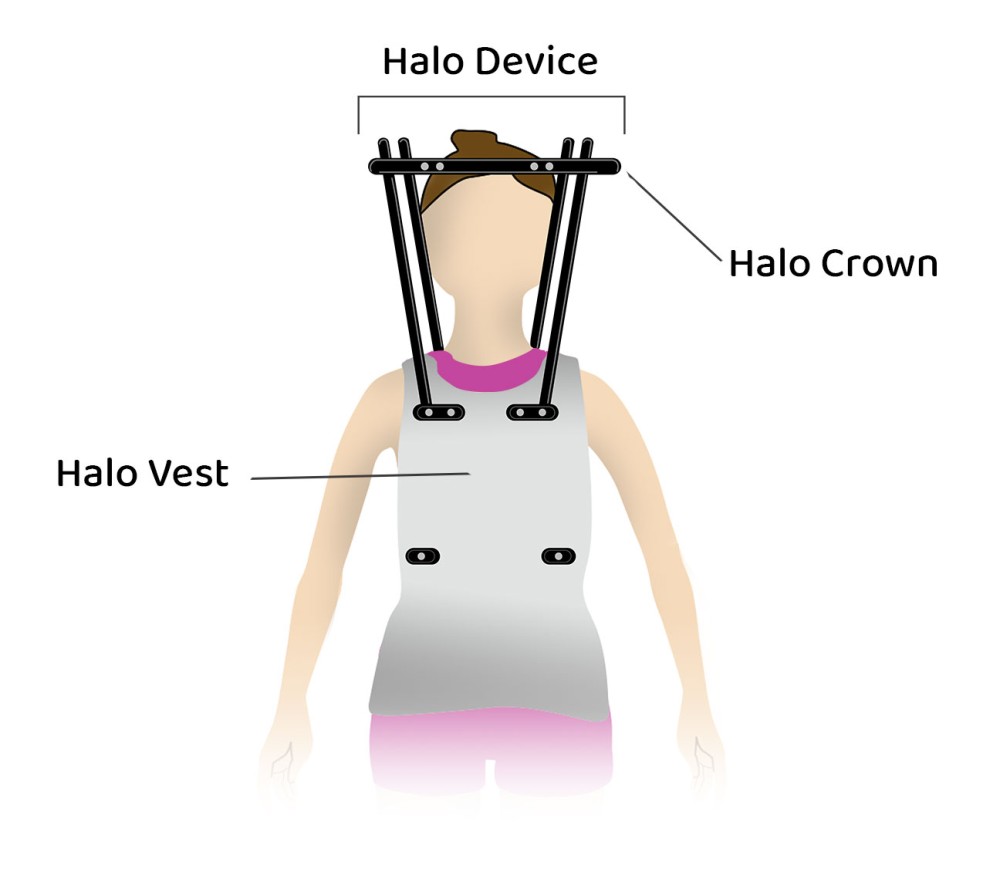What is a halo vest?
A halo vest is sometimes used after spinal surgery, spine fractures, or dislocations because the vertebrae heal when movement is limited. The vest fits snugly to support the healing spine. Once your child’s brace specialist checks the fit, only your provider should remove it.

How do you wear a halo vest?
The added weight of the vest will affect your child’s balance and upper mobility. Your child can use a walker or a cane for assistance if needed.
When your child is in a vest, large, roomy clothes will be most comfortable. Shirts that open in the front, shirts with raglan or dolman sleeves, pleated and wrap-around skirts, and gathered pants with elastic waists work well. Velcro closings and snaps make closing easier to pull on and take off.
When it is time to sleep, a small, soft pillow under your child’s neck can relieve strain on muscles and alleviate pressure on pins. If sleeping is difficult when lying flat, try a recliner, a wedge or several extra pillows in bed.
Change positions every two hours, rotating gently. Relieve pressure to red spots by lying on the opposite side.
Please remember that a halo vest should only be removed by your child’s provider. However, in emergency situations, you may need to remove it yourself. If that is the case, you can find instructions here: emergency halo vest removal.
How do you clean a halo vest?
The halo vest is made of hard plastic and lined with fleece. Keep the lining dry. The fleece will mat and cause irritation if it gets wet too often. You can wash the plastic part of the vest with a cloth that’s been dampened in clear water.
Making sure your halo vest and pins are clean is crucial. To make pin care easier, prepare a tray with all the needed supplies. Perform pin care daily, or more often if directed by your provider. Clean pin sites with sterile normal saline, using a sterile cotton-tipped applicator.
If crusting is present, wrap the pin sites for 20 minutes with gauze that has been soaked in normal saline. Remove crust with a sterile cotton-tipped applicator that has been soaked in normal saline.
Avoid aggressive cleaning, which can cause irritation. If the pin site begins to look infected, contact telehealth/your provider. They may recommend you begin cleaning with a half-strength hydrogen peroxide solution (half hydrogen peroxide, half sterile water) or may recommend a course of antibiotics.
How do you bathe in a halo vest?
Clean under the vest once a day, using a damp washcloth to reach under edges of the vest. Use a long handles sponge or tongs to reach your back and buttocks. Dry skin with a clean, dry washcloth. Use a larger body towel that is damp with clean water. Thread it through the front of the vest. With one end at the top and the other at the bottom, gently move back and forth. Use care, because forcing it through can cause skin burns. Repeat with a dry towel. And repeat on the front side. Don’t use soap near the vest, because it might cause skin problems.
Shampoo hair as often as needed, but at least twice a week. It might be helpful to have your child hang over the edge of the bed while you pour water over their hair. Put a large wastebasket on the side so that it can catch all the water. Dry the metal part of the halo and do a pin care after shampooing.
How do you care for skin with a halo vest?
Check all areas where the bones are close to the skin and vest, such as the tailbone, shoulder blades, collarbones, hips and ribs. Check the skin on back, stomach and sides. Look for skin soreness and make sure to smell for any foul odors.
You can help stop itching by using a hairdryer- set on low/cool only- to blow air under the vest. A caregiver can also use a 24-inch-long piece of stockinet that’s slightly dampened with witch hazel. Thread it through the front of the vest. With one end at the top and the other at the bottom, gently move back and forth. Use care, because forcing it through can cause skin burns. Never use sharp objects to scratch under the vest.
Your Care Team
Typically, your child’s provider will want to see you for follow up and x-rays may be taken to check the spine’s position. Your child’s provider will discuss next steps and treatment moving forward during this meeting.
Your child’s comprehensive treatment plan might include working with experts from a variety of specialties:
- Orthopedics and surgical inpatient care
- Pediatric intensive care
- Radiology and imaging
- Rehabilitation medicine
- Rehabilitation therapies
- Surgery
- Orthotics, prosthetics and seating
- Gait and motion analysis
- Minnesota’s first Level I Trauma Center for Children
- Adult Services (for older teens and adults)
Please remember that a halo vest should only be removed by your child’s provider. However, in emergency situations, you may need to remove it yourself. If that is the case, you can find instructions here: emergency halo vest removal.
 Home Page
Home Page



